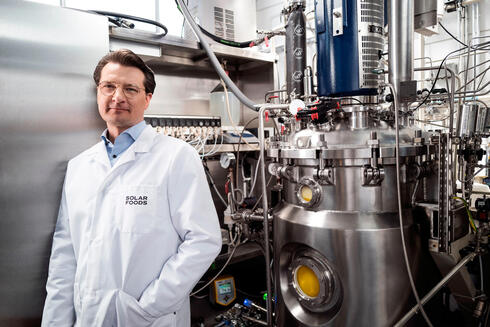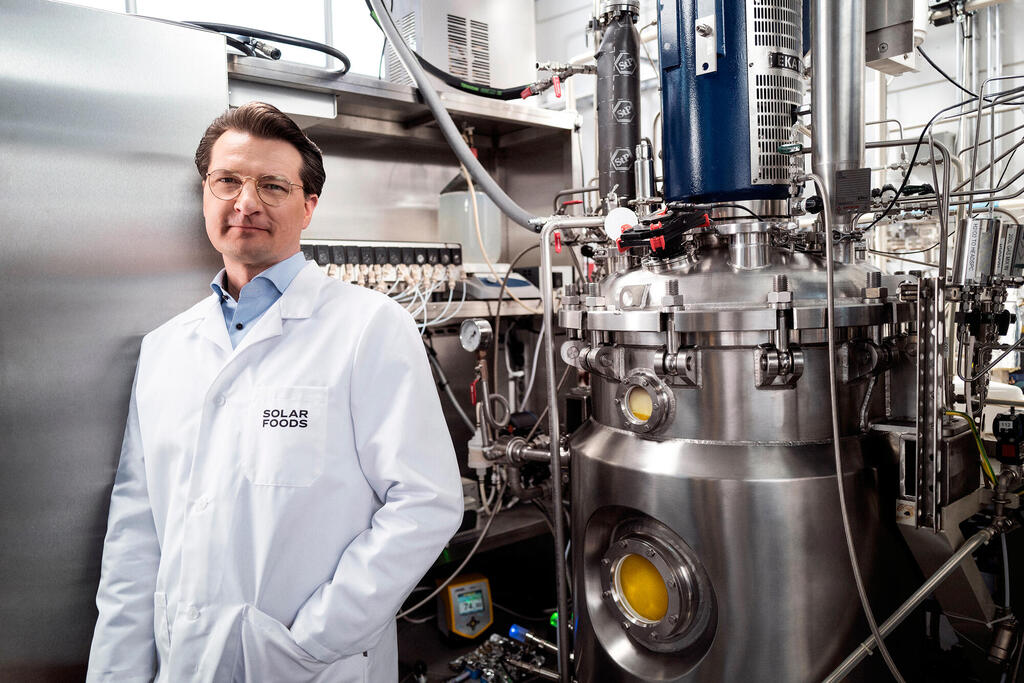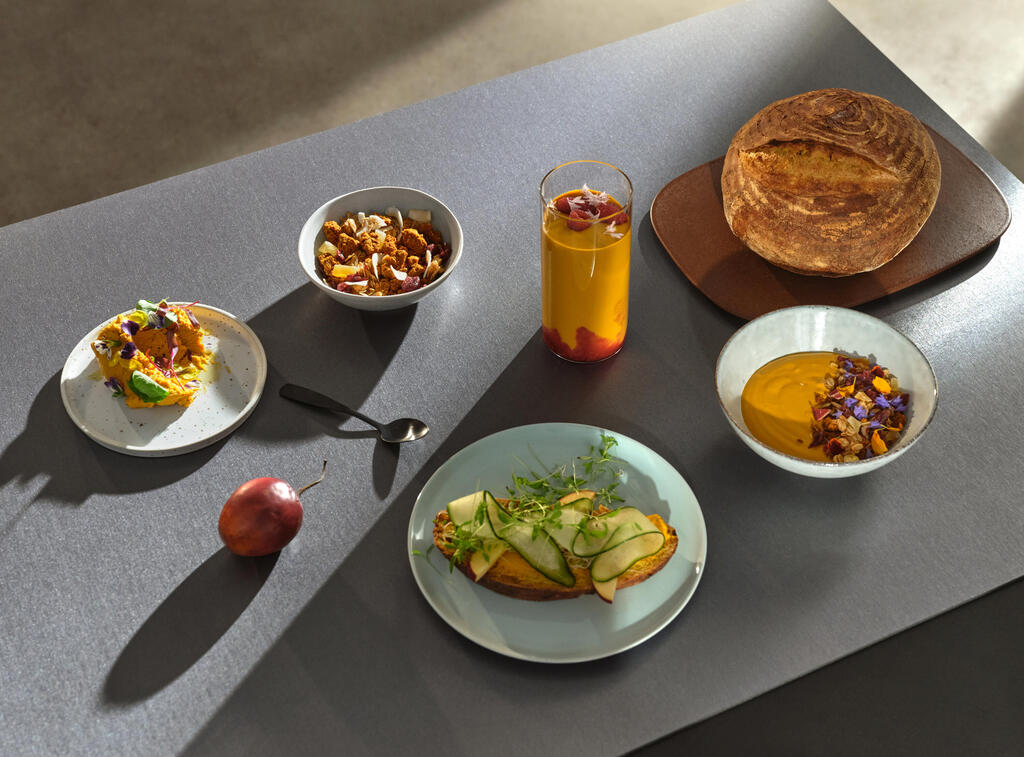
Interview
Power of powder: Solein seeks to shake up food industry
From a small laboratory in the suburbs of Helsinki, Dr. Pasi Vainikka, CEO of Solar Foods, is about to create a historic revolution in the world of food: a protein powder that is made of 95% air - without a single gram of soil, and with zero ecological footprint - and it's healthy too
At first glance, it's hard to get excited about Solein. It is a fine powder, whose golden color would place it somewhere between turmeric and saffron. The smell is even less enticing: it is not aggressive, but mainly reminds one of the smell of a scrambled egg. Rhis may be another one of the protein powders that threaten to take over the animal food industry - meat, milk and eggs. But Solein claims to bring about a much greater revolution in human nutrition and the way we prepare food, thanks to the main raw material from which it is prepared: air.
This is not a mistake. Solein makes it possible to prepare a huge variety of food products—cereals, pancakes, ice creams, meatballs, steaks, and the list just keeps getting longer—from carbon dioxide drawn from the air. All this with no cows, no antibiotics and no fertilizers, in an efficient and economical process. In an age of a food crisis and a deepening climate crisis intertwined, in which the agricultural industry plays a significant role in both, this is jaw-dropping news. No wonder, then, that Solein will receive regulatory approval in Europe at the end of 2023, and that the company developing it, Finland’s Solar Foods, has already raised 66 million euros.
Solein can be used in several categories in the food world, explains Dr. Pasi Vainikka, the company's CEO and one of its two founders, in an interview from the company's laboratories in Espoo, a suburb of Helsinki. "One type of product will be liquid, and will include a whole range of milk substitutes, shakes, yogurt and ice cream. Another option is to use heat and pressure and thus create a fibrous structure from the powder, which is suitable for a plant-based meat substitute. You can also use it to thicken and enrich different foods with protein such as noodles, soups, cereals, etc. You can also simply use it instead of an egg in pancakes and breads, for example."
And all this from thin air?
"We use gas fermentation technology: we put a certain bacterium into the fermentation tank, the growth medium in which is water that contains micronutrients (components required by the body in small amounts, such as vitamins and minerals) and ammonia as a nitrogen source. The heart of the matter is the way we feed this organism: it feeds on hydrogen and carbon dioxide, which we supply to it as bubbles. So the raw materials are 95% air - nitrogen, hydrogen and carbon dioxide. So we let the organism continue its life, grow and reproduce, and when the container is full, we dry the bacteria and turn them into food, which contains 70% protein, includes all nine essential amino acids, is low in carbohydrates and rich in vitamin B and iron."
But the potential environmental benefit of Solein is two-fold and multiplied, because the gasses used to produce it are captured directly from the atmosphere, in a way that practically helps to clean it. "The environmental footprint of our protein is one-hundredth that of meat protein, and one-tenth that of plant-based protein," says Vainikka. "In the vast areas that are cleared (when there is no need to raise animals or sow vast fields) it is possible to preserve habitats, plant trees, or simply stop deforestation."
This environmental revolution, Vainikka explains, is also what led to the choice of the company's name, Solar Foods: "The idea is that you can grow food in the desert by 'milking' carbon and water from the air with direct carbon capture technology, with the electricity required for the process coming from the sun. So our product will have a systemically significant impact in the long term on the carbon reset of the food industry."
50 years after NASA abandoned the research, the Finns revived it
Vainikka (45), a mechanical engineering doctor who wrote his PhD on renewable energies, is a stern scientist with an almost robotic drawl. The Guardian's influential environment correspondent, George Monbiot, described him as someone who may not pass the Turing test (a test designed to determine whether a machine has artificial intelligence). And yet, when Vainikka describes the enormous scope of this project, it's hard not to be amazed. "We're actually turning the wheel back 200 million years, focusing on single-celled life forms," he explains. "The name Solein is derived from the name of the organism at the heart of the process, which we found in nature. It's a non-photosynthetic microbe, meaning it doesn't feed on sugar, but uses hydrogen as an energy source."
So the food of the future is actually "a primordial soup of bacteria taken from the soil," as Monbiot put it. In his new bestseller, "Regenesis", Monbiot describes how a pancake prepared for him with salt instead of egg made him see the light for the first time since he became a vegan in 2016: "A small step for a pancake, and a giant step for humanity," he wrote there.
The reference to Neil Armstrong's iconic quote is accurate, because the foundations of Solar Foods technology were laid in a comprehensive study conducted for NASA as early as 1967, and the results of which were spread over no less than 153 pages. The study tried to find a solution to one of the biggest problems of space missions: how to feed astronauts on missions that would last more than a year, the length of time during which the decrease in the nutritional values of the food products starts to become evident. One of the ways detailed in the study sounded like science fiction: capturing the carbon that the astronauts emit when they exhale, and storing it in a closed container with a strain of microorganism, which will feed on it and turn it into available protein. But in the early seventies, NASA's budget was cut to 1% of the federal budget, about a quarter of its previous rate. The Apollo 18-20 programs were shelved, and with it the revolutionary research.
The idea, however, continued to excite the imagination of many scientists—among others in Finland, where follow-up research was conducted in collaboration with the Finnish Center for Technological Research (VTT), which is a national research institute, and Lappeenranta University of Technology (LUT). Vainikka and his partner, Juha-Pekka Pitkänen, founded Solar Foods as a spin-off of this Finnish study in 2017, at the end of the jubilee of the publication of the NASA study.
According to them, the connection between their technology and NASA's research is quite loose. "Tesla did not invent the electric car, but what they are doing today is very different from the first electric car, which was invented almost 150 years ago," explains Vainikka. "This life form, of bacteria hydrogen oxides, was indeed identified by NASA as part of early space exploration, but it was never used, because the space missions were relatively short and in low satellite orbit, so the food they were equipped with was sufficient. So the essential discovery did belong to NASA, but it had no practical meaning since the sixties. Our technology is not related to NASA, we developed it ourselves, even if it can be perceived as a kind of modification: a more detailed and commercial version of the foundations that were laid down then."
Solar Foods, which receives generous financing from banks and government funds in Finland and all of Scandinavia (it received a loan of 10 million euros from the Finnish climate fund, and last month raised 15 million euros from Danske Bank, the largest bank in Denmark), maintains a dialogue with NASA through another channel. About half a year ago the company was one of the winners of NASA's "Deep Space Food Challenge", and its cooperation with the agency continues even now, against the background of the Artemis plan to return to the moon. "The need to produce food in space is an important issue in space exploration, and now, with the renewed ambition to reach Mars, it is once again the center of attention," Vainikka explains. "As part of our collaboration with NASA, we are developing a small facility, the size of a refrigerator, that can feed six crew members on a mission to Mars."
Isn't that overly ambitious? Such a task is currently estimated to take at least a year and a half. One refrigerator could feed six people for all that time?
"I don't want to sound arrogant, but historically, a great many technologies have been developed or perfected as part of space exploration, for example photovoltaic technology. Now, we hope to teach NASA and allow them to use our development to speed up their development even more."
“Our product is the answer to the questions my grandchildren will have"
Solar Foods is not the only company trying to extract protein from air. Its direct competitor is America’s Air Protein, which was founded shortly after it, in 2019; raised slightly less than it, $32 million; and lags behind it in the race to obtain regulatory approvals. Another company in the foodtech field, whose product uses carbon capture from the air, is Air Company, which already produces and markets vodka "with a negative carbon footprint." According to the company, the vodka in each of its bottles removes a liter (450 grams) of carbon from the atmosphere.
However, Air Protein's business model is that of an "alternative to a dish": it tries to develop the end products of the process, such as "steak" or "salmon". Solar Foods, on the other hand, aims to cooperate with the existing food companies. "Our business as a company is to market the powder to other businesses (B2B), as an ingredient for food manufacturers," Vainikka says. "The reason for this is that there are hundreds of companies around the globe that process plant-based ingredients into various types of meat substitutes, so we prefer to allow them to expand their range and empower them. The battle we have chosen is over the main ingredient. We leave the consumer end products to those who know the market better than us."
What is your biggest challenge right now?
"We call it 'burden of proof'," he smiles. "Our significant burden for several years has been to prove that the product is suitable for mass production, and that it is safe. Last October, we submitted all the documents to the European Food Safety Agency, and since the approval process lasts two years, we aim to enter the market at the end of 2023 - a year and a half from now.
"As for Israel, as far as I know, as soon as regulatory approval is received in the United States or Europe, it adopts this approval quite quickly. We also recently submitted an application for food approval in Singapore and we hope to receive approval within a few weeks, but we will only be able to sell limited quantities there that we are currently producing in our pilot, where there is a facility with a volume of 200 kg. But I think we have proven long ago that our product is safe."
Is your production process more expensive than the existing meat alternatives?
"The price of Solein for the industry will be 5 euros per kg - more than soy, which costs 2 euros per kg, or even less if these are soybeans grown for animals, but less than pea protein, which costs 6-12 euros per kg."
And Vainikka is wary of promises, but it is quite possible that the final product will also be healthier than what is common in the meat substitute market. "The protein from Solar Foods is supposed to be better for us than vegetable protein," explains Dr. Tami Miron, an expert in food product development and the technology director of the food-tech incubator Fresh Start (not related to Solar Foods). "Vegetable protein often has anti-nutrients which make it difficult to absorb the protein, and in many cases it is not a complete protein because it lacks necessary amino acids."
What are the challenges facing this technology?
"One barrier may be the composition of the air, which is not constant anywhere in the world and varies in the parameters of carbon dioxide concentration, humidity, temperature, etc., so the question is how to control the concentrations and create a uniform process. A second barrier is efficiency, in terms of fermentation time (4 days are required from the moment the air is milked until the product is ready) and other parameters.”
But the big challenge, she says, will be the final taste and texture. "In the developments I made with similar protein sources, I got the impression that it was necessary to give them another twist, or add more components to them, in order to produce products with an experience similar to animal products. Currently, most products that provide a good user experience contain stabilizers and thickeners, which are less healthy for us. In addition to that, processes may be required in the protein production process to get rid of dyes and after tastes. On the other hand, we may be able to create a more functional protein with properties such as adhesion and gelation."
We should receive the answers to these questions very soon, Vainikka says. "For the past two years we have been involved in a significant recruitment project, aiming to build our first commercial plant and prove that a facility the size of a bus can produce many tons of Solein every year."
You describe a future where we eat mostly powders. Doesn't that take the fun out of the food?
“Surprisingly, I actually believe that new food technologies, whether it is cultured meat, specific proteins, milk substitutes, eggs without eggs, or what we are doing - all, by the way, types of fermentation - will strengthen the existing food systems. I see it as coexistence. The new technologies and the food ingredients that are developed with their help will provide nutrition in different portions during the week - for example lasagna, where you have no way of knowing whether its ingredients are cultured or not. At the same time, meat, milk and eggs have an important cultural history, and they represent more than food and calories, so if on Saturday morning you want to enjoy a piece of meat or an egg, you might appreciate them more and agree to pay more for them. This will provide adequate compensation for the loss of resources and the damages associated with their growth.”
It is a powerful motivator - not only from the aspect of humanity, but also on your personal aspect.
“I have a PhD in an engineering due which I am aware or the harm man does for the planet. If and when environmental catastrophes happen in the future, I belong in that part of educated global population that should have seen catastrophes coming. Therefore, when in swing chair at my 80’s, I will be held accountable for my grandchildren. On that day when they ask: ‘Grandpa, what is it you did for the planet when you learned about the climate change and loss of natural ecosystem’, I better have a good explanation.”
First published: 16:31, 19.08.22
















